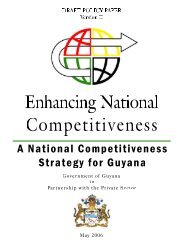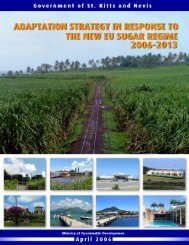Business Removing
Doing Business in 2005 -- Removing Obstacles to Growth
Doing Business in 2005 -- Removing Obstacles to Growth
- No tags were found...
Create successful ePaper yourself
Turn your PDF publications into a flip-book with our unique Google optimized e-Paper software.
30 DOING BUSINESS IN 2005<br />
What to reform?<br />
Bold reforms, as in Colombia or Slovakia, have the largest<br />
payoffs in increasing productivity, reducing unemployment,<br />
and providing women with better economic and<br />
social opportunities. In the absence of such sweeping<br />
change, four types of reform work best:<br />
• Increase the length and scope of term contracts.<br />
• Introduce apprentice wages.<br />
• Allow flexible working hours.<br />
• Remove administrative approvals for dismissals.<br />
Increase the length and scope of term contracts<br />
In 1991 Peru revised its labor law to allow for a 3-year<br />
term contract for any task. The previous law allowed<br />
1-year contracts for temporary tasks. Within a year, the<br />
number of workers on term contracts shot up by 50%<br />
and by 1997 more than doubled, to make up 40% of all<br />
employment contracts. Young and informal workers<br />
benefited the most, with youth unemployment falling by<br />
7 percentage points and the informal sector shrinking<br />
by 12 percentage points. 17<br />
Five of last year’s reformers—Croatia, Italy, Poland,<br />
Portugal and Slovakia—increased the duration of term<br />
contracts and expanded their applicability. Germany<br />
and Russia did the same the previous year. In those 2<br />
countries and in Poland, there is no limit to the length<br />
of term contracts. Portugal increased the duration to 6<br />
years, Slovakia to 5, Italy to 3.<br />
But term contracts are a good reform only when it is<br />
difficult to reduce the cost of regular contracts—and<br />
even then as a temporary measure. If they are not accompanied<br />
by reforms of regular contracts, term contracts<br />
could contribute to the development of a dual<br />
labor market—as evidenced in Spain. 18<br />
Introduce apprentice wages<br />
Thirty countries have apprentice wages, ranging from<br />
Chile to Madagascar, Thailand to Tunisia, Serbia and<br />
Montenegro to Australia. Apprentice wages are a 1990s reform,<br />
except for Denmark, France and some Latin American<br />
countries, which have had them since the 1960s. Such<br />
reform is cheap: the beneficiaries are easy to target, and<br />
the apprenticeship lasts a short time, after which the employee<br />
enters a regular contract. 19 It is also easier to introduce<br />
apprentice wages than to lower the minimum wage,<br />
because labor unions oppose them much less.<br />
Allow flexible working hours<br />
To accommodate fluctuations in demand, a business<br />
may at times need longer workweeks—hopefully not too<br />
often. <strong>Business</strong>es in the Czech Republic, Hungary and<br />
Poland found this the hard way. With employment regulations<br />
that permitted only 150 hours of overtime a<br />
year in the mid-1990s, and with limits to term contracts,<br />
much demand remained unmet. All 3 countries reached<br />
an innovative solution: to allow swaps of working hours<br />
between peak periods and slow periods, as long as the<br />
number of hours remained constant over the course of 6<br />
months (Poland) or a year (Czech Republic, Hungary).<br />
Poland soon found that a 6-month period was inadequate,<br />
because seasonal demands usually require an annual<br />
cycle.<br />
More recently, many Central European economies<br />
have found a complementary solution: longer overtime<br />
hours, with the consent of employees. Latvia increased<br />
the overtime hours to a maximum of 432 a year, Hungary<br />
and Slovakia to 400, Poland to 260. The combination<br />
of time swaps within the normal work hours and<br />
expanded overtime makes it possible for businesses to<br />
adjust to swings in demand.<br />
About 50 countries allow flexible working hours. In<br />
the others, temporary increases in demand mean lost revenues<br />
or higher production costs. For example, the normal<br />
workweek in Indonesia is 40 hours, and 3 additional<br />
hours of overtime per day are allowed. The premium for<br />
overtime work is 50% for the first hour, and 100% thereafter.<br />
So to meet an increase in temporary demand of 50%<br />
the owner of a 200-employee company would have to hire<br />
19 new workers. 20 The labor costs on that 50% output increase<br />
would rise by 96%. In Venezuela, where only two<br />
hours of overtime work per week are allowed, at a 50%<br />
premium, the business would have to hire 66 new workers<br />
and the labor cost would increase by 90%. Countries<br />
that move to more flexible work hours can bring those<br />
labor costs down considerably—Slovakia from 111% to<br />
27%, Namibia from 54% to 39% (figure 4.5).<br />
Remove administrative approvals to dismissals<br />
Many countries have both high administrative barriers<br />
and large direct costs of firing. If a business owner in Sri<br />
Lanka decides to fire a redundant worker, she needs to<br />
obtain approval from the labor union. This takes time.<br />
Often, the case ends up in the labor tribunal, involving<br />
further costs and delays. Fines are frequently levied for<br />
failing to comply with this or that procedure. And once

















